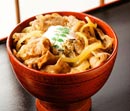 |
Hitachi Beef
Gyu-don (beef bowl) is a very popular dish that also appears on the menu at fast food restaurants in Japan. You don't want to miss this recipe, which tells you how to make the "magic sauce" by mixing dashi, mirin and soy sauce in a proportion of 7/5/3, allowing anyone to prepare this delicious rice-bowl menu. The fat in Hitachi Beef is very tender and its exquisite juicy flavor permeates into the rice. |
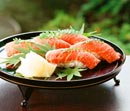 |
Shimane Wagyu Beef
"Sushi," a characteristically healthy Japanese specialty, is becoming a worldwide craze. Although sushi is usually made from seafood, with the use of Shimane Wagyu Beef, with its savory flavor of fat and creamy and tender texture, you can produce a most flavorsome sushi that is reminiscent of fatty tuna. |
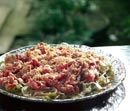 |
Miyazaki Wagyu
Blanche sliced beef until it turns to a slightly rosy color, cool it, and make it into a salad with some crispy vegetables. It is rich in nutrient and has a refreshing taste, perfect for summertime when people tend to lose their appetite. Be careful not to boil it too much so as not to spoil the tenderness of the Miyazaki Wagyu. |
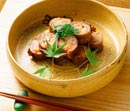 |
Kyoto Beef
Original yahata-maki is burdock, formerly a local specialty in Yahata area of Kyoto, which was rolled inside eel or loach meat. However, beef is popular for use in home cooking. Tender Kyoto Beef with slightly sticky fat is perfect for this dish, easy to make rolls out of and delicious to eat. |
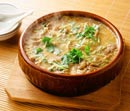 |
Kazusa Wagyu
Yanagawa-nabe is simmered loach and burdock bound together with egg. This menu is prepared with the use of beef instead of loach. Burdock and beef complement each other well. The tender texture of Kazusa Wagyu matches the refreshing crispy texture of the burdock. |
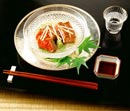 |
Yamagata Gyu
The "tataki" is to brown the surface only slightly while keeping inside still rare. The taste of beef is condensed by making tataki, so you can enjoy both the crispy surface and tastiness inside. Savor the rich taste of Yamagata Gyu, characterized by its mellow flavor. |
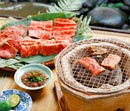 |
Kagoshima Wagyu
Yakiniku (barbecued beef) is a cuisine that originates in Korea. The straightforward method by which beef is simply barbecued is also popular as an outdoor pastime. Enjoy the rich and tasty flavor of Kagoshima Kuroushi with this refreshing sauce. |
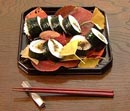 |
Bushu Wagyu
Sushi rolls can be easily eaten by hand without worrying about them falling apart, and as such it is among the staple menu items for packed lunches. This sushi roll, featuring “shigure-ni,” which can be preserved over a long period, made of Bushu Wagyu, with its characteristic fine texture and sweetness, is perfect for packed lunches for outings. |
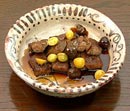 |
Tochigi Wagyu
For teriyaki dressed with a slightly sweet gravy, the rich fat of Tochigi Wagyu adds a glossy finishing touch. |
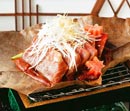 |
Tajima Beef
Houba-yaki is a dish prepared by grilling miso (soybean paste) and other ingredients on a leaf of the Japanese Magnolia ("hou" in Japanese), which grows in the alpine forests of the Hida Region (in the northern part of Gifu Prefecture). It represents the local cuisine of the Hida Region, wherein you can enjoy the aroma of magnolia leaves and miso. The rich taste of Tajima Beef goes perfectly with the flavor of miso. |
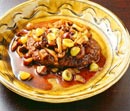 |
Akita Yuri Beef
This is a nutritious hamburger steak wherein tofu and rice are used instead of bread crumbs, and is served with a teriyaki flavor. It is a unique fusion of Japanese and Western cuisines. Hamburger steaks with the rich minced meat of Akita Yuri Beef are very tender and juicy. |
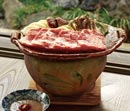 |
Kobe Beef
Toban-yaki means to roast on a ceramic plate. Ceramic plates continue to emit heat for a long time after removal from their heat sources, and also have a significant heat radiation effect. Therefore, ceramic plates are perfect for roasting ingredients in an even fashion. Kobe Beef, with its characteristic fine marbled texture, can be roasted on such plates, producing a tender and juicy steak. |
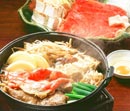 |
Joshu Wagyu
One of the best known Japanese dishes in the world is "sukiyaki." It originated from "gyu-nabe (beef hot pot)," which became extremely popular in the Meiji Era immediately after the period of national isolation, when Western-style cuisine was imported from abroad. You can enjoy your fill of the fine texture and taste of Joshu Wagyu with this recipe. |
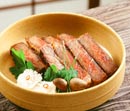 |
Ohmi Beef
Miso-zuke (food preserved with miso paste) is a traditional Japanese cooking wherein ingredients are broiled after having been covered with miso paste, one of the most important components of the Japanese diet. One example of this is "miso dengaku, " which is broiled tofu with miso paste, a dish often said to constitute the origin of oden . It is also known to have a nutritional fortification effect. Enjoy the rich taste of Ohmi Beef and the flavor of miso with this recipe. |
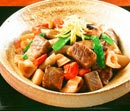 |
Hakata Wagyu
"Chikuzen-ni" is a stewed dish originally from the Kyushu Region. It is particularly tasty when left to sit some time after cooking and keeps well. This is why it is a staple dish that is prepared ahead of time for the New Year holiday when women are traditionally freed from kitchen work. Although chicken is usually used for chikuzen-ni , here we use tender Hakata Wagyu with a refined taste so as to make a luxurious dish. |
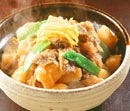 |
Hiroshima Beef
"Niku-jaga" (stewed meat and potato) is a representative home-style Japanese dish. Its origin is unique in that Admiral Heihachiro Togo, a Meiji-era naval officer, tried to reproduce the beef stew he ate when he was studying in the United Kingdom. Hiroshima Beef retains its tender texture even after stewed, and the flavor permeates thoroughly. |
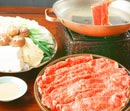 |
Matsusaka ushi
Shabu-shabu is a manner of eating extremely thin slices of meat blanched in boiling water. It originated from a Chinese dish wherein mutton is used. The quality of the ingredients is crucial for this quite simple dish. One can fully enjoy oneself with the luxurious taste of Matsusaka Ushi, which is referred as an “artwork of beef” with its fine marbling and delicate flavor. |
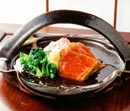 |
Kumamoto Aka Ushi
This roast beef is made in an original Japanese style by way of steaming, which slowly allows the flavors to blend, rather than oven roasting. The surface is crispy brown, and although the inside is freshly rose-colored, the flavor of the soy sauce and sake permeates right through to the center. In this was you can enjoy the pleasant chewy texture of Kumamoto Aka Ushi. |
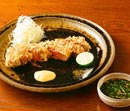 |
Iwate Shorthorn
Although pork is usually used to make cutlets in Japan, beef cutlets are also popular in parts of the Kinki Region such as Osaka. The Iwate Shorthorn has less fat so it makes for a healthy dish even when deep-fried. A light and refreshing sauce further brings out the flavor of the beef. |
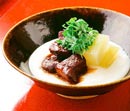 |
Mukaku Wagyu
"Yamato-ni" (Japanese-style simmered beef) is a traditional Japanese dish wherein ingredients are cooked slowly with sugar and soy sauce. Mukaku Wagyu, with its rich umami flavor and low fat content, becomes even tastier when simmered or stewed. The rich taste goes very well with rice or sake. Mashed potato is also served in a Japanese style. |



